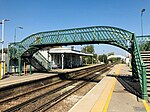St Mary's Church, Hampden Park, Eastbourne
1908 establishments in England20th-century Church of England church buildingsChurch of England church buildings in East SussexChurches completed in 1954Churches in Eastbourne ... and 2 more
EngvarB from July 2019Grade II listed churches in East Sussex

St Mary's Church (dedicated to St Mary the Virgin) is the Anglican parish church of the Hampden Park suburb of Eastbourne, a town and borough in the English county of East Sussex. Originally linked to the church at nearby Willingdon, it later became a separate parish church. The first building was destroyed by a bomb during World War II, and Edward Maufe was commissioned to design a replacement church; the hilltop building, finished in 1954, has been called "one of his most charming designs". English Heritage has listed it at Grade II for its architectural and historical importance.
Excerpt from the Wikipedia article St Mary's Church, Hampden Park, Eastbourne (License: CC BY-SA 3.0, Authors, Images).St Mary's Church, Hampden Park, Eastbourne
Decoy Drive,
Geographical coordinates (GPS) Address External links Nearby Places Show on map
Geographical coordinates (GPS)
| Latitude | Longitude |
|---|---|
| N 50.7969 ° | E 0.2717 ° |
Address
St Mary's
Decoy Drive
BN22 9PR , Ratton
England, United Kingdom
Open on Google Maps







